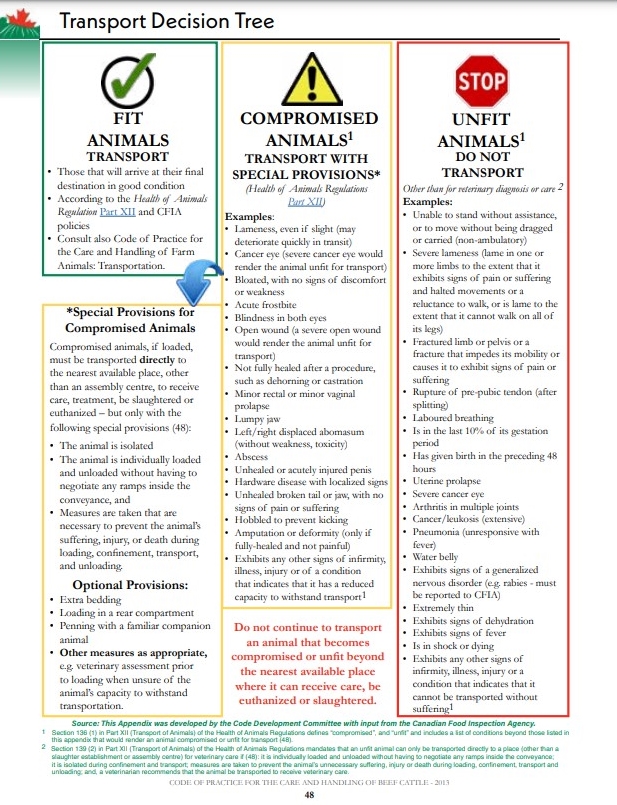Transportation of Beef Cattle
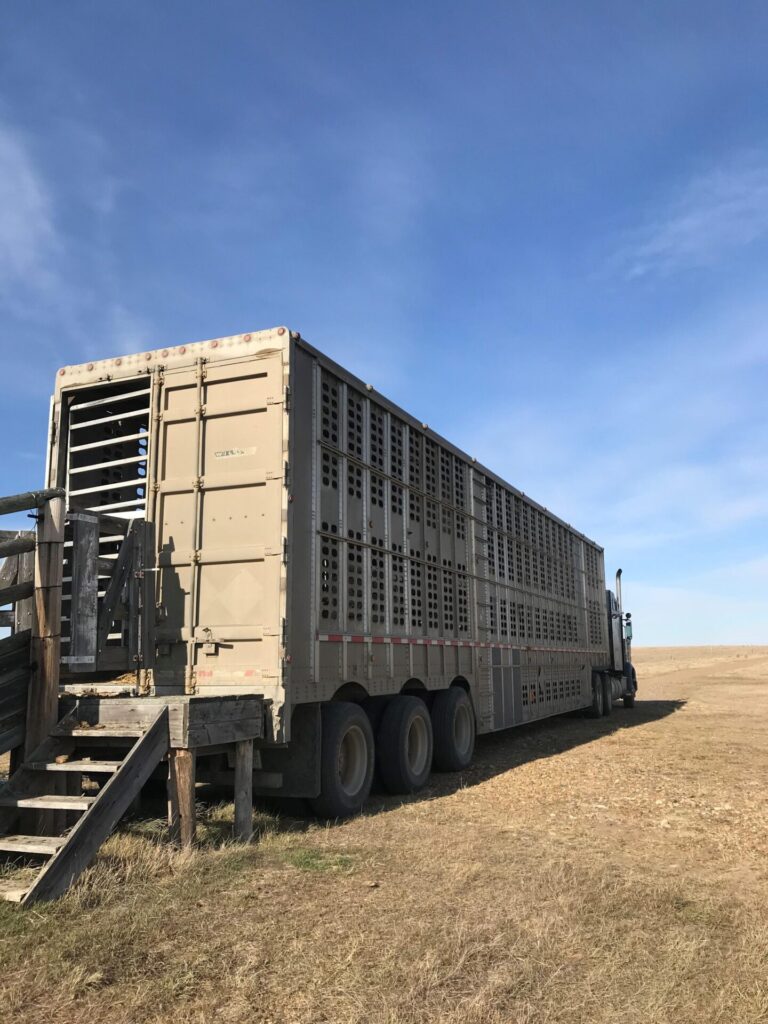
Ensuring the safety and wellbeing of beef cattle during transport is important to farmers and ranchers, transporters, and the public.
Cattle transport in Canada is a critical element for beef production and marketing. Nearly all beef cattle are transported several times in their lives. Livestock transport is complex and can impact animal health and well-being, and consequently meat and carcass quality. Using best practices for transport, including pre- and post-transport handling, can improve animal health and welfare in all parts of the beef value chain, from cow-calf through to feedlot operators, packers, and retail sectors.
Good transport outcomes require teamwork and communication between farmers, transport drivers, inspectors, and the final destination.
| Key Points |
|---|
| The largest Canadian beef cattle transport study ever completed determined that 99.98% of beef cattle in transit for short hauls (4 hours or less) and 99.95% of cattle in transit on long hauls (4 hours or more) reach their destination with no serious problems. |
| The same benchmarking study found that the time for long-haul trips averaged 16 hours in length, and more than 95% of cattle spent less than 30 hours in transit. |
| The Canadian Food Inspection Agency, along with federal and provincial counterparts, regulates livestock transport in Canada under Part XII of the Health of Animals Regulations. |
| Pre-transport decisions are critical. Transport affects different classes of cattle in different ways. Yearlings and fat cattle are often at lower risk of injury, lameness, or other poor welfare outcomes while market cows and weaned calves are at higher risk. |
| Minimize stress before, during, and after transport by using proper handling techniques and facilities to load and unload cattle. |
| High risk animals (e.g. old, thin cows) should be the last to load and the first to unload. They should never be loaded in the doghouse. |
| Market cows (i.e. culls) are at a greater risk of becoming compromised during transport than other classes of cattle. Transport when temperatures are below 30oC and above -15oC, use proper bedding, avoid long distances, and maintain proper loading densities. |
| The “Code of Practice for the Care and Handling of Beef Cattle” was released in 2013 with input from industry, animal care specialists, academics, veterinarians, government, and animal welfare advocacy groups like the Canadian Federation of Humane Societies. This code includes standards and protocols for pre-transport decision making, loading and receiving beef cattle. |
| A “Made in Canada” transport course, called the Canadian Livestock Transport Certification Program, is available. Click here to learn more. |
An Important Issue for Canadians
The public takes an interest in the welfare of cattle during transportation and handling. Most Canadians have little contact with farms and encountering cattle trailers on the highway may be their first point of contact with livestock. Scientific evidence and sound policies supporting Canadian beef cattle transport and handling regulations are increasingly valued by industry in order to maintain a social license to operate.
Transport Regulations and Codes in Canada
Livestock transportation in Canada is subject to regulations at multiple levels. The Canadian Food Inspection Agency, along with federal and provincial counterparts, regulates livestock transport in Canada under Part XII of the Health of Animals Regulations.
In February 2020, the changes to the Transport of Animals Regulations came into effect. The four major changes that these new regulations focus on are:
- categorizing animals fit for transport,
- record keeping for transporters,
- required feed, water and rest times and
- contingency planning.
Canada’s Health of Animals Regulations and the National Farm Animal Care Council’s Transportation Code of Practice are currently undergoing amendments and updates.
To learn more about these changes to the Transport of Animals Regulations, head to the BCRC blog “updated livestock transport regulations and what you need to know”.
The Canadian Food Inspection Agency is responsible for animal welfare during transport including aspects such as loading densities, potentially compromised animals, bedding requirements and duration of transit. Transport Canada’s Commercial Vehicle Drivers Hours of Service Regulations govern how often drivers need to stop for rest. Maximum trailer lengths and axle weight limits fall under provincial and territorial jurisdiction.
Canadian Research on Transport
Canada is vast and has a beef cattle industry, transport system, and climate unlike other countries around the world. Canada’s recommended cattle transport practices and regulations must reflect those differences and be scientifically sound. Research that studies commercial cattle and transport trailers under typical commercial distances and conditions in Canada is the most relevant for guiding transport standards.
Driver fatigue increases the risk of livestock transport accidents. Research that documented accidents in Canada and the United States determined that 59% of accidents occurred from midnight to 9:00am and 80% of all livestock transport accidents were single-vehicle.
Canadian research demonstrated that 99.98% of short haul (4 hours or less) and 99.95% of long haul (4 hours or more) beef cattle reach their destination with no serious problems.
There is currently very limited research on the effect that loading density can have on animal welfare and profitability. However, it is known that both excessive and insufficient space allowance during cattle transportation have the potential to be detrimental for animal well-being and profitability. Research findings have shown that too much or too little space allowance can increase the frequency of falls, injuries, bruising, and mortality and reduce meat quality. Space allowance during animal transport is a highly debated issue, and it is a complicated issue to deal with under commercial situations because drivers have to comply with both maximum axle weight regulations and animal welfare. Therefore, several considerations come into play including the number of axles in the trailer, cattle size and weight, body condition, presence of horns, environmental conditions, and the distance that animals will be transported. Further research is required to understand and improve weight distribution and space allowance among compartments, and to understand the effect that loading density can have on animal welfare.
Canadian scientists conducted a series of three studies on the effects of rest stops during long-haul transit. Their results found that preconditioning helped calves travel better, but rest stops did not provide any clear, across-the-board benefits for all groups of calves and might pose extra challenges to non-preconditioned calves.
Stress can increase the risk of diseases like BRD, so research was conducted to determine how transportation rest stops affect the respiratory microbiome in cattle. The results from the study found that rest stops during transportation, auction market placement, and longer transportation times may be risk factors for BRD, based on increased abundance of BRD associated genera in the upper respiratory tract after cattle were placed in feedlots. Because BRD incidence was low in the studies performed, it was not possible to correlate the abundance of BRD-associated genera to animal health. Larger-scale studies are needed to confirm how these transportation variables impact BRD incidence.
While there are still many transport research questions to answer, Canadian researchers have worked to:
- Establish welfare benchmarks for common industry transport practices
- Determine welfare benchmarks for compromised cattle transport
- Investigate the effects of loading density and trailer ventilation management (trailer side boards) on calf transport outcomes, welfare and health
- Examine how driver experience impacts shrink and welfare outcomes
- Determine the impact of unloading delays on welfare
- Investigate the effects of animal and handler behaviour, transport conditions, time and distance and transit, and driving practices on welfare outcomes and carcass impacts in fed cattle and market cows
- Investigate the effects of rest stop duration and quality as well as cattle type on welfare outcomes after transport
Maintaining Welfare During Transport of Cattle
Cattle may be exposed to numerous stressors before, during, and after transport. Handling during loading or unloading, being exposed to new environments such as auctions, mixing with unfamiliar cattle, or feed and water restrictions all cause stress. Other factors such as loading density, injuries or illnesses, duration of transit, and trailer environmental conditions, such as humidity, temperature, and ventilation, also affect welfare.
Handle Animals with Care to Prevent Stress
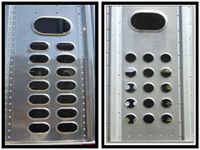
Photo credit: Agriculture and Agri-Food Canada
Handling and loading facilities should have solid sides, be free of broken boards or protrusions, and be well lit. Chutes should have non-slip footing, such as rubber mats, sand, gravel, or perforated concrete flooring. Loading ramps should also have traction (i.e. perpendicular cleats), be at an angle of 25° or less and have no gaps between the ramps and the cattle liner. Cattle should be handled as calmly and quietly as possible during both loading and unloading to prevent bruising and other injuries related to slipping or falling.
In addition to the risk of transport injury, stress can depress the immune system. Steps taken to avoid or reduce stress in transport will reduce the risk of animals becoming sick after the trip is completed. Ensure that cattle:
- are not wet
- have the opportunity to eat and drink within five hours of loading
- have adequate bedding in trailer compartments for the duration of transit
- are loaded at an appropriate density
- have adequate ventilation during periods of time when the trucks are stationary, particularly in warm weather (> 15 °C)
Loading Decisions and Determining Risk
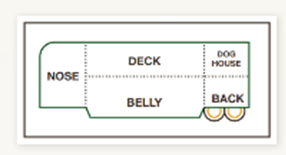
Loading decisions are critical to a successful transport outcome. Producers must ensure that the animals they load are not unfit or compromised in any way. Sick or injured animals, or cattle suffering for any other reason, are not fit for transport.
Commercial transport trailers typically contain several compartments. Cattle are sorted for each compartment according to weight and class. It is important to determine the risk level of animals and know that different classes of cattle may be at greater transport risk than others. High risk cattle should not be placed in the doghouse, and should be the last to load and the first to unload.
High Risk
Any class of animal can be a high risk to transport if the animal is sick, injured, or otherwise compromised. Market cows (i.e. cull cows) are often at the greatest risk of being compromised during transport, especially those that are older, thinner and weaker. In winter, thin haired dairy cows from an insulated barn are faced with additional challenges, particularly if they are still lactating.
When transporting market cows, pay particular attention to loading density, weather conditions and the duration in transit. Market cows should be well bedded, segregated, and when possible, loaded in the back compartment so that they are loaded last and unloaded first.
Cows with a body condition score (BCS) of 1 (5-point BCS scale) should never be transported. Cows with a BCS of 2 should only be transported short distances.
Medium Risk
Any class of cattle can be a medium risk to transport if they are exposed to stress. During the fall run, calves may be more tired and stressed due to a combination of weaning stress, commingling with calves from other herds, and unfamiliar feed and water in livestock markets. These calves may be at higher risk of injury in transit, and are much more likely to get sick as a result of this accumulated stress. Calves are at greater risk for poor welfare outcomes as the time in transit increases, especially around the 30 hour mark. Calves are also more sensitive than fat cattle to external temperature below -15 degrees or above 30 degrees Celsius.
Low Risk
Finished and yearling cattle are young, healthy and have good nutritional reserves, which helps them to easily withstand transport stress.
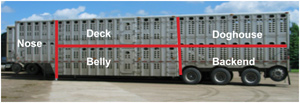
Use a Responsible Livestock Transport Company
Transporting live loads of cattle is much different than static freight. Responsible livestock haulers play an important role in making sure animals reach their destination safely.
Drivers should:
- avoid rapid acceleration
- avoid any sudden stops or sharp corners
- stop periodically to check that the cattle are safe (i.e. no animals have gone down)
- adhere to appropriate feed, water and rest intervals
- maintain communications with receiver before and following arrival to help manage any challenges
- have a plan to deal with inclement weather, vehicle malfunctions, road construction, or any delays that increase the time animals are on the truck
- be familiar with cattle behaviour and follow optimal handling practices while loading and unloading cattle
Record Keeping for Transporters
Two documents are required for transport as per the changes to the Transport of Animals Regulations that came into effect in February of 2020. These documents focus on recording the status of animals before they are loaded in, in transport and upon transfer of care. However, one document may be used to serve both purposes as long as all required information is included.
Animal Transport Record- This record must include:
- the shipper’s name and address,
- driver’s name, license and registration,
- trailer floor area and when/where the trailer was last disinfected,
- animal description including number, weight, time of loading, if animals are fit for transport and any special provisions for any compromised animals and
- the last time the animals received feed, water and rest.
This document is to be written and retained by anyone transporting animals in the course of business for a period of two years.
Transfer of Care Record- This document is only needed for auction marts, slaughter facilities or assembly centres and must include the following information:
- date and time of arrival,
- condition of animals and
- date and time of the last feed/water and rest.
This document is to be retained by the receiver for a period of two years. The transfer of care from the transporter to the receiver occurs immediately upon acknowledgement of the shipment and the accompanying Transfer of Care Record.
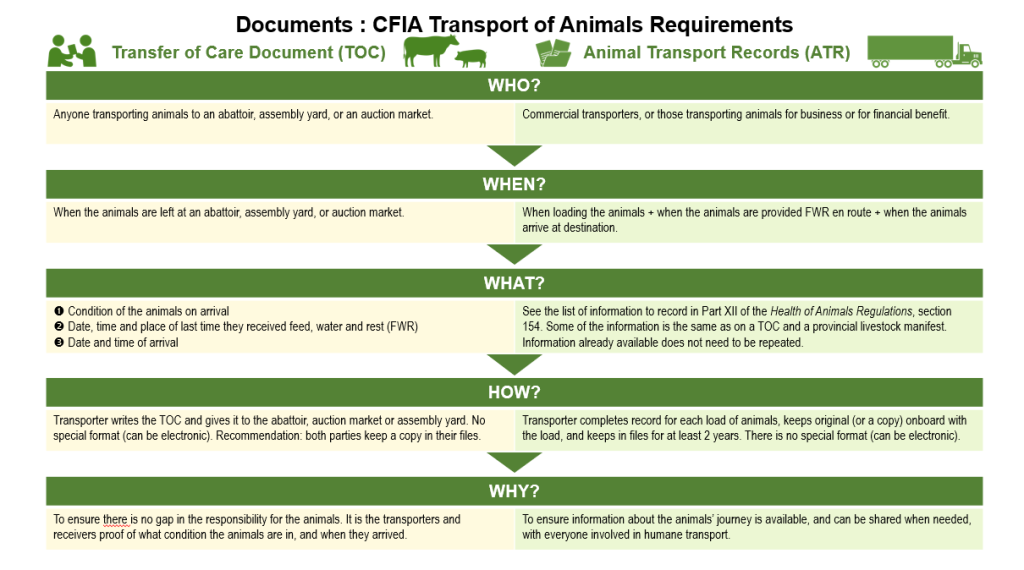
Facility Design and Transport Procedures to Prevent Carcass Bruising
Carcass bruising costs producers. Bruises are trimmed from the carcass before it is weighed, meaning the producer is paid for fewer pounds. To minimize bruising from transport, cattle must be handled carefully using well-designed facilities, and loaded on trailers with proper footing at appropriate densities.
Handling during loading and unloading can be more stressful than transport itself. Improper animal handling has a negative effect on meat quality and also has negative welfare implications and potentially reduces consumer confidence.
Facilities can be designed or modified to improve handling:
- Incorporate chutes with solid sides to keep the animals focused on moving ahead
- Curved chutes promote flow by taking advantage of an animal’s tendency to walk in a circular manner
- Provide non-slip footing by placing grooves in concrete floors, using metal grids, applying sand or dirt to the area, or using rubber matting
- Maintain facilities, replace broken or protruding boards, panels, nails, bolts, or other metal hazards
- Ensure handling area is well lit with non-direct lighting that doesn’t shine in the animal’s face
- Loading docks or ramps should not have any gaps between the ramp and the cattle liner
- Ramp should not be at an angle steeper than 20-25°
- Ensure the loading ramp has perpendicular cleats at regular intervals to provide proper footing
Low-stress cattle handling is the practice of moving cattle calmly and slowly, with infrequent, or no use of electric prodding. Low-stress handling includes reduced noise, refraining from shouting, handling cattle in small groups as opposed to individually and avoiding use of unfamiliar animals or untrained dogs.
- References
-
Goldhawk, C., Janzen, E., González, L.A., Crowe, T., Kastelic, J., Kehler, C., Siemens, M., Ominski, K., Pajor, E., and Schwartzkopf-Genswein, K.S. (2015). “Trailer temperature and humidity during winter transport of cattle in Canada and evaluation of indicators used to assess the welfare of cull beef cows before and after transport.” Journal of Animal Science. Volume 93 (7) pages 3639-53.
González, L.A., Schwartzkopf-Genswein, K.S., Bryan, M., Silasi, R., and Brown, F. (2012). “Space allowance during commercial long distance transport of cattle in North America.”, Journal of Animal Science. doi: 10.2527/jas.2011-4771
González, L.A., Schwartzkopf-Genswein, K.S., Bryan, M., Silasi, R., and Brown, F.A. (2012). “Benchmarking study of industry practices during commercial long haul transport of cattle in Alberta, Canada.”, Journal of Animal Science. doi: 10.2527/jas.2011-4770
González, L.A., Schwartzkopf-Genswein, K.S., Bryan, M., Silasi, R., and Brown, F.A. (2012). “Factors affecting body weight loss during commercial long haul transport of cattle in North America.”, Journal of Animal Science. doi: 10.2527/jas.2011-4786
González, L.A., Schwartzkopf-Genswein, K.S., Bryan, M., Silasi, R., and Brown, F.A. (2012). “Relationships between transport conditions and welfare outcomes during commercial long haul transport of cattle in North America.”, Journal of Animal Science. doi: 10.2527/jas.2011-4796
Woods, J., and Grandin, T. (2008). “Fatigue: a major cause of commercial livestock truck accidents.”, Veterinaria Italiana. Volume 44 (1), pages 259-262.
Feedback
Feedback and questions on the content of this page are welcome. Please e-mail us at info@beefresearch.ca.
Acknowledgments
Thanks to Dr. Karen Schwartzkopf-Genswein, Agriculture and Agri-Food Canada Researcher focused on animal welfare standards and reducing transport stress in farm animals for contributing her time and expertise to writing this page.
Ce contenu a été révisé pour la dernière fois en Août 2023.
